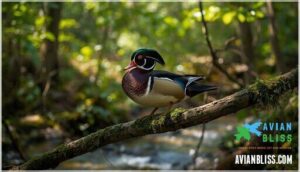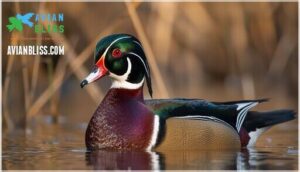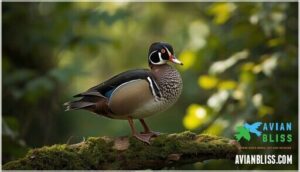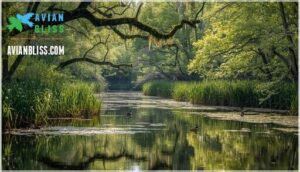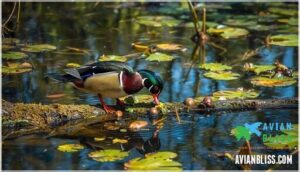This site is supported by our readers. We may earn a commission, at no cost to you, if you purchase through links.
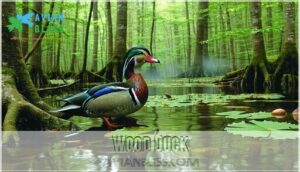
Their significant recovery from near-extinction in the early 1900s tells a conservation success story, while their complex life cycle and specialized habitat needs make them fascinating subjects for wildlife enthusiasts and researchers alike.
Table Of Contents
- Key Takeaways
- Wood Duck Physical Characteristics
- Wood Duck Habitat and Range
- Wood Duck Behavior and Life Cycle
- Wood Duck Diet and Feeding Habits
- Wood Duck Conservation and Threats
- Frequently Asked Questions (FAQs)
- What is the most notable characteristic of wood ducks?
- What do wood ducks eat?
- What does a wood duck look like?
- What is the natural habitat of a wood duck?
- Is it rare to see a wood duck?
- What states do wood ducks live in?
- Can I keep a wood duck as a pet?
- What kind of trees do wood ducks nest in?
- Are wood ducks any good to eat?
- Why are wood ducks special?
- Conclusion
Key Takeaways
- Wood ducks represent one of North America’s greatest conservation success stories, recovering from near-extinction in the early 1900s to over 3.5 million birds today through hunting regulations, habitat restoration, and nest box programs.
- These unique waterfowl are cavity nesters that require large mature trees near water for breeding, making them dependent on specific forest-wetland ecosystems that combine wooded swamps, beaver ponds, and bottomland hardwood forests.
- Male wood ducks display stunning iridescent green and purple plumage during breeding season, while females maintain cryptic brown coloring year-round, and both sexes can be identified by their distinctive boxy crested heads and blue-green wing patches.
- Their omnivorous diet shifts seasonally from 80% invertebrates during breeding season to support egg production, to primarily plant matter including acorns and aquatic seeds during fall and winter months.
Wood Duck Physical Characteristics
If you’ve ever spotted a wood duck, you know they stand out among other ducks. Their physical features are both beautiful and easy to recognize. Here’s what makes them unique.
Size, Shape, and Wingspan
Wood ducks showcase a distinctive silhouette that sets them apart from other waterfowl. Adult size range spans 18.5 to 21.3 inches in length, with males slightly larger due to sexual dimorphism. Their wingspan variation of 26 to 29 inches, combined with unique body shape adaptations—including a boxy crested head and broad tail—affords superb flight maneuverability through dense woodland environments.
They’re known to inhabit bottomland streams surrounded by woodlands.
Male Wood Duck Plumage
Males display striking breeding plumage from February through July, featuring an iridescent green crested head with white facial stripes and a rich chestnut breast. Their red eyes and bill create striking contrast against metallic purple-green coloration.
During eclipse molting between June and September, they temporarily lose these hues for muted grayish-brown feathers, though red features remain for identification.
This coloration arises from light interacting with melanin-pigment containing organelles.
Female Wood Duck Plumage
Unlike their flashy counterparts, female Wood Ducks wear understated olive-gray to brown plumage year-round—perfect female camouflage for nesting duties. You’ll spot them by their distinctive white teardrop eye patches and blue speculum that catches light during flight.
This consistent coloration results from hormonal influence, with estrogen maintaining their cryptic appearance. Their plumage molting occurs subtly, preserving these reliable Wood Duck identification marks.
Juvenile and Eclipse Plumage
Young Wood Ducks and adult males undergo fascinating plumage transformations that can confuse even experienced birders. Understanding these changes helps you identify Wood Ducks throughout their annual cycle and distinguish between age groups during field observations.
Here’s what you need to know about juvenile molt and eclipse camouflage:
- Juvenile appearance: Juveniles resemble adult females but appear duller with spotted undersides and muted wing patterns
- Eclipse male transformation: Adult males molt into cryptic brown plumage during summer, retaining only their distinctive red eyes
- Molt timing: Peak eclipse plumage occurs July through September, coinciding with the flightless molting period
- Plumage differentiation: Juvenile males show duller bills compared to eclipse males, while breeding readiness triggers autumn feather restoration
Key Identification Features
Spotting these distinctive waterfowl becomes easier when you focus on their most reliable distinguishing marks. Male plumage features iridescent green heads with white facial stripes, while female plumage shows characteristic white teardrop eye-rings.
Both sexes display blue-green speculum details with white trailing edges during flight identification. Their boxy crested heads and rectangular tails make Wood Ducks unmistakable among North American ducks.
Wood Duck Habitat and Range
Wood ducks aren’t picky about where they call home, but they do have some clear preferences regarding their surroundings. You’ll find these adaptable birds in a mix of wetland and woodland environments across much of North America.
Let’s look at the specific habitats they favor and how their range shifts throughout the year.
Preferred Wetland and Forest Habitats
You’ll find wood ducks thriving where water meets mature forest. These birds need forested wetlands with cavity availability in large deciduous trees like oak and maple. Brood habitat requires 75% vegetative cover mixed with open water channels.
Forest composition matters—beaver ponds and floodplain forests create ideal conditions. Wetland interspersion within ten acres prevents habitat fragmentation that threatens breeding success.
Regional Distribution in North America
Across North America, wood duck distribution spans three distinct regions that shape their survival story. Eastern populations dominate from Atlantic Canada to Florida, while western distribution centers on Pacific coastal states. Central migration corridors connect Canadian breeding grounds to Gulf Coast wintering areas.
Here’s where you’ll encounter these stunning waterfowl:
- Eastern strongholds – Mississippi River Valley to Atlantic coast, supporting 449% population growth since 1971
- Western refuges – British Columbia to California, hosting 60,000 birds in scattered coastal habitats
- Central flyways – Manitoba to Texas, following major river systems past the Rocky Mountains
- Coastal wintering havens – From North Carolina’s marshes to Louisiana’s delta, providing year-round residence for southern populations
Seasonal Migration Patterns
Wood duck migration patterns follow predictable seasonal rhythms driven by temperature and food availability. Northern populations migrate south between October and November along Mississippi and Atlantic flyways, while southern birds remain year-round residents. Migration triggers include frozen wetlands and declining daylight.
Wintering regions concentrate along Gulf Coast marshes, with route variation depending on mate selection and climate influence affecting traditional flyway dynamics.
Habitat Requirements for Nesting
Successful wood duck nesting habits depend on specific breeding habitat requirements that determine reproductive success. These cavity-nesting ducks need precise conditions for optimal box utilization and natural tree cavities.
Key nesting requirements include:
- Cavity size – Natural or artificial cavities must measure 4+ inches in diameter with 24-inch interior depth
- Nest proximity – Cavities within 0.5 miles of water sources help duckling survival
- Habitat vegetation – Bottomland hardwood forests with 1:1 cover-to-water ratios provide essential protection
- Limiting factors – Cavity availability remains the primary constraint, making nest boxes vital conservation tools
Wood Duck Behavior and Life Cycle
Wood ducks live fascinating lives that revolve around water, trees, and seasonal rhythms. Their behavior changes dramatically throughout the year, from elaborate courtship displays in late winter to complex nesting habits in tree cavities.
Understanding these behavioral patterns helps you appreciate how these notable waterfowl have adapted to their unique ecological niche.
Courtship and Pair Bonding
Like a carefully choreographed dance, wood duck courtship displays begin as early as September and peak between December and February. Males perform “Wing-and-Tail-Flash” sequences, while females emit loud “oo-week” calls that stimulate vocal communication among competing suitors.
Hormonal influence drives this mating seasonality, with breeding plumage signaling readiness. Pair-bond stability increases through winter, ensuring synchronized breeding success.
Nesting and Breeding Habits
Once paired, your wood ducks face the challenge of nest site selection. Females choose tree cavities 2-60 feet high, preferring spots near water within 1.2 miles.
She’ll lay 6-16 cream-colored eggs in her down-lined nest, incubating them alone for 25-37 days. Brood parasitism can inflate clutch size beyond 30 eggs, though nest boxes help guarantee successful duckling fledging after this lengthy breeding process.
Social and Territorial Behaviors
After nesting, you’ll notice wood ducks display fascinating social dynamics. Males practice mate-guarding behavior rather than defending fixed territories, chasing rival drakes during mating season.
Communication signals like crest displays and vocal calls maintain flock social hierarchy, with dominant birds accessing prime feeding zones.
Nesting parasitism occurs when females lay eggs in others’ nests—up to 40% engage in this territorial behavior strategy.
Flocking and Flight Patterns
Beyond territorial displays, wood ducks showcase impressive flight agility through dense woodlands. You’ll observe their erratic, darting flight patterns as they weave between trees with quick directional changes.
Roosting behavior involves evening flights to communal sites, usually starting eight minutes after sunset. Flock dynamics remain small—most groups contain fewer than 12 birds.
Migration timing varies regionally, with northern populations showing pronounced flocking during November departures.
Wood Duck Diet and Feeding Habits
Wood ducks are opportunistic feeders with a varied diet that changes throughout the year. You’ll find these adaptable birds eating everything from acorns and aquatic plants to insects and small invertebrates.
Let’s explore what fuels these beautiful waterfowl through different seasons and life stages.
Omnivorous Diet Overview
Wood ducks are nature’s flexible eaters, thriving on an omnivorous diet that changes to whatever their wetland homes provide. Their feeding habits showcase remarkable versatility, with diet composition shifting between plant materials and animal prey based on seasonal availability and energetic needs.
- Plant foods make up 80% of their annual diet – seeds, fruits, and aquatic plants fuel their daily activities
- Invertebrates provide essential protein – especially important for growing ducklings and breeding females
- Feeding techniques include dabbling and land foraging – they’re equally comfortable in water and on shore
- Seasonal variation drives dietary changes – more insects in spring, more nuts and seeds in winter
- Their ecological impact extends beyond feeding – they disperse seeds and control insect populations naturally
Plant-Based Foods and Seeds
Seeds form the cornerstone of wood duck nutrition, with acorns serving as premium energy sources that pack the caloric punch of raw soybeans.
You’ll find these dabblers targeting smartweed, pondweed, and duckweed in diverse wetland habitats, where seed nutritional value drives their foraging choices.
Their plant matter preferences support both personal survival and important seed dispersal roles across aquatic ecosystems.
Invertebrate and Aquatic Prey
When breeding season arrives, female wood ducks dramatically shift their feeding strategy, consuming up to 80% invertebrates to fuel egg production.
You’ll discover these protein-rich prey items sustain critical reproductive processes:
- Aquatic larvae, crustaceans, and mollusks from flooded wetlands
- Terrestrial beetles, snails, and spiders from forest vegetation
- Calcium-rich snails supporting eggshell formation
- Dragonflies and mayflies during summer abundance peaks
Habitat influence determines prey availability across their range.
Seasonal Changes in Diet
As seasons shift, you’ll notice dramatic changes in wood duck feeding behavior. Spring invertebrates provide essential breeding nutrition, comprising 10-14% of their diet. Autumn acorns dominate intake at 18%, building winter reserves through carbohydrate-rich plant matter.
Geographic variation influences these seasonal changes—northern populations move earlier to invertebrate feeding, while southern birds rely heavily on hardwood wetland seeds.
Wood Duck Conservation and Threats
Wood ducks have faced a rollercoaster ride with regard to survival—from near extinction to impressive recovery. Their story shows how conservation efforts can turn things around, but new challenges keep emerging.
Let’s look at the key moments in wood duck conservation and what threats they’re dealing with today.
Historical Population Decline
By the early 1900s, wood ducks faced near extinction—a clear illustration of what unchecked exploitation can do. Market hunting and habitat loss created a perfect storm that decimated populations across North America.
By the early 1900s, unchecked market hunting and habitat loss had driven wood ducks to the brink of extinction
The decline happened fast and hit hard:
- Market hunting operated year-round before the 1918 Act, targeting wood ducks for meat and feathers
- Rapid deforestation eliminated 70% of nesting trees in prime breeding areas
- Wetland drainage for agriculture destroyed critical brood habitat
- Data gaps from limited early monitoring made tracking population decline difficult
- Regional severity varied, with Atlantic and Mississippi Flyways suffering the worst losses
This conservation crisis would test early wildlife protection efforts.
Legal Protection and Recovery
The 1918 Migratory Bird Treaty Act became wood duck conservation’s turning point. MBTA effectiveness showed immediately—complete hunting bans until 1940 let populations stabilize.
Nest box programs replaced lost tree cavities, while habitat restoration rebuilt wetlands. These conservation efforts triggered substantial population rebound.
By combining hunting regulations with wildlife management practices, wood duck population recovery became North America’s conservation success story.
Current Conservation Status
Today’s wood duck conservation status tells an impressive recovery story. The IUCN Red List classifies them as “Least Concern,” with North American populations exceeding 3.5 million birds.
You’ll find stable or increasing numbers throughout most ranges, thanks to decades of habitat restoration and population monitoring.
Despite ongoing threats like wetland drainage and climate impacts, current conservation efforts maintain healthy populations above federal target goals.
Ongoing Threats and Management Efforts
While conservation status looks promising, you’ll encounter several ongoing threats to wood ducks that require active management. Habitat loss continues as wetlands disappear—the Mississippi Valley alone lost over 19.5 million acres of critical bottomland forest. Climate impacts from drought and rising temperatures stress remaining wetlands, while predation eliminates 86-90% of chicks within two weeks of hatching.
Fortunately, extensive management efforts address these challenges through multiple strategies. Habitat restoration projects received $46.2 million in 2024 grants to restore 90,000 acres across 17 states. Nest box programs maintain nearly 33,000 monitored boxes nationwide, contributing to 38-65% of successful second and third nesting attempts. Hunting regulations under adaptive harvest management keep populations stable, while predation control through nest box guards greatly improves duckling survival rates.
Frequently Asked Questions (FAQs)
What is the most notable characteristic of wood ducks?
The most stunning plumage variations you’ll ever see define wood ducks perfectly. Male wood duck plumage showcases breathtaking color iridescence and sexual dimorphism, while female wood duck plumage offers subtle beauty through specialized feather structure.
What do wood ducks eat?
Wood ducks are omnivores with complex dietary adaptations. Their feeding strategies shift seasonally—plant matter dominates fall diets while aquatic invertebrates fuel spring breeding. Juvenile diet emphasizes protein-rich invertebrates supporting rapid growth and development.
What does a wood duck look like?
Picture a duck that looks like it stepped out of a jewelry box. Male plumage features iridescent green heads with white facial stripes, while female markings include subtle brown tones and distinctive white eye-rings around dark eyes.
What is the natural habitat of a wood duck?
Forest ecosystems with shallow water create ideal conditions for these waterfowl. You’ll find them in wooded swamps, beaver ponds, and tree-lined streams where wetland conservation efforts maintain the aquatic habitats they need for survival.
Is it rare to see a wood duck?
Actually, you’re likely to spot these waterfowl more often than you’d expect. Wood ducks have rebounded dramatically from near-extinction through successful conservation efforts and habitat restoration programs. With approximately 3 million breeding pairs across North America, they are now a common sight.
What states do wood ducks live in?
You’ll find these waterfowl across most eastern and central states, from Atlantic Canada to the Gulf Coast.
They also inhabit Pacific Northwest regions, with concentrated populations along the Mississippi and Atlantic flyways.
Can I keep a wood duck as a pet?
You can’t legally keep these waterfowl as companions. Pet Ownership Laws under the Migratory Bird Treaty Act strictly prohibit Wild Duck Capture without federal permits, protecting wild populations from Domestication Risks through thorough Permit Requirements.
What kind of trees do wood ducks nest in?
Large mature deciduous trees like oak, cypress, and sycamore provide ideal cavity nesting characteristics.
These cavity nesters prefer trees exceeding two feet in diameter, usually 60+ years old, located near wetland wood duck habitats within forest ecosystems.
Are wood ducks any good to eat?
Yes, wood ducks are excellent eating. Their meat offers a rich, slightly sweet flavor profile reminiscent of prime rib. Proper cooking methods like roasting or grilling boost their tender, juicy meat quality markedly.
Why are wood ducks special?
Wood Ducks showcase unique adaptations like tree-cavity nesting and stunning iridescent plumage.
Their conservation success story, ecological role in wetland ecosystems, and aesthetic appeal make them culturally significant symbols of wildlife recovery efforts.
Conclusion
Witnessing a wood duck’s waterside wanderings reveals nature’s striking resilience. These stunning waterfowl transformed from near-extinction to thriving populations through dedicated conservation efforts and habitat protection.
Their unique tree-nesting behavior, vibrant plumage, and adaptable feeding habits make them exceptional ambassadors for wetland ecosystems.
By understanding their complex needs—from wooded swamps to seasonal migration routes—you’re better equipped to appreciate and protect these iridescent jewels that grace our waterways with their presence.
- https://www.ducks.org/conservation/waterfowl-surveys/2025-duck-numbers
- https://realtree.com/duck-hunting/articles/early-2025-duck-numbers-look-mixed
- https://www.audubon.org/field-guide/bird/wood-duck
- https://woods-n-waternews.com/2025/10/01/the-wood-duck-revival/
- https://www.dnr.state.mn.us/birds/woodduck.html

